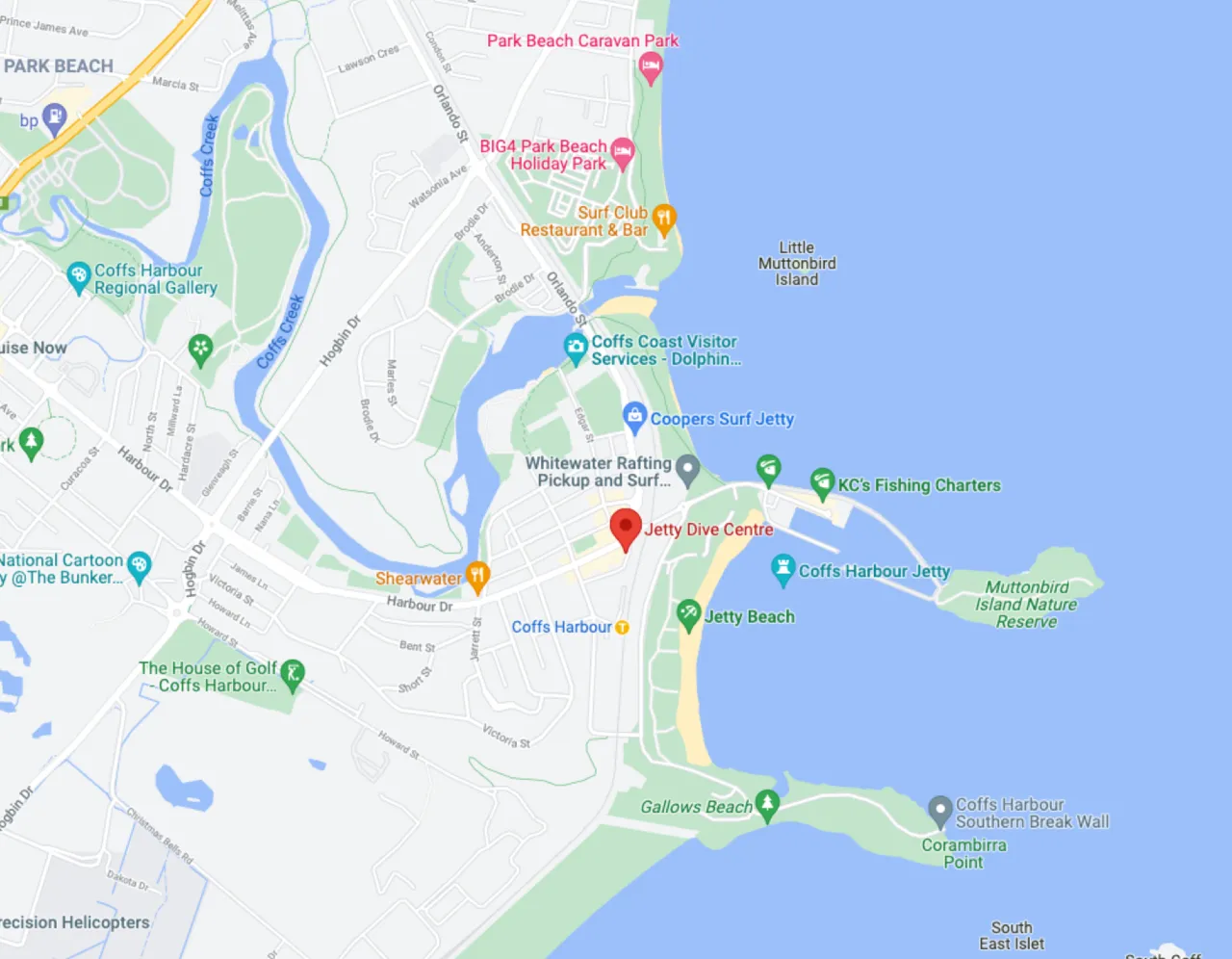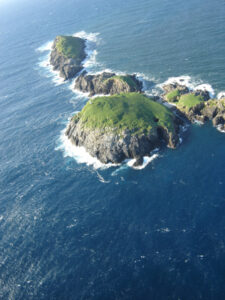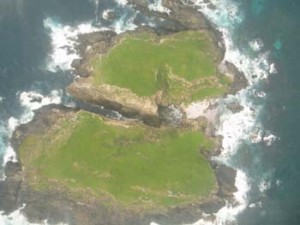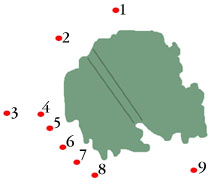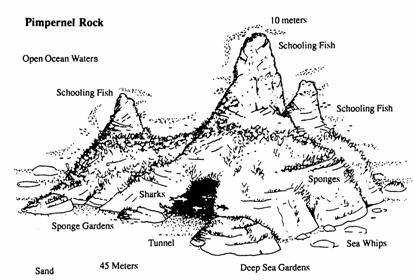Dive Sites of the Solitary Islands Marine Park
Dive Sites of the Solitary Islands Marine Park – Table of Contents:
- South Solitary Island (cont.)
The Solitary Islands Marine Park is host to many islands and with them a variety of dive sites. Thankfully, Jetty Dive Centre is ideally located at the gateway to the Solitary Islands Marine Park. All our tours and charters leave from the Coffs Harbour marina into the Park. Coffs Harbour being centrally located between Sydney and Brisbane on the NSW north coast.
The Solitary Islands Marine Park extends along about 75km of coastline from Coffs Harbour to Sandon River. Established in Jan 1998, it’s been a Marine Reserve since 1992. More Information on the Solitary Islands Marine Park can be found HERE.
This is where the warm Great Barrier reef waters from the north, meet the cooler southern waters from Sydney and below – the sheltered Island havens are warmer than the coastal waters producing a unique blend of tropical and sub-tropical fish life, hard and soft corals, and spectacular marine life. Diving Coffs Harbour truly does offer more to see than Diving the Barrier Reef.
South Solitary Island
Just 30-40 minutes by boat from Coffs Harbour and off the coast by 8km.
South Solitary Island, known as “The Light”, usually boasts clean water and has nine fantastic dive sites. Typical marine life found includes Blue Groper, Grey Nurse Sharks, Wobbegongs, Shovelnose Rays, Bull Rays, Eagle Rays, Loggerhead Turtles, Frogfish, Anglerfish, King Fish, Bannerfish, Jewfish, Trevally, Wrasses, Moray Eels, Giant Cuttlefish, Blue Tangs, Clownfish, Nudibranchs, and the list goes on and on…
Here are some of it’s stunning sites… Click the name of the site for more information and some pics of what you’ll see!
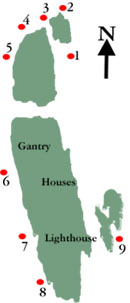
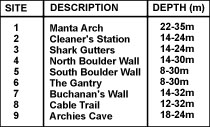
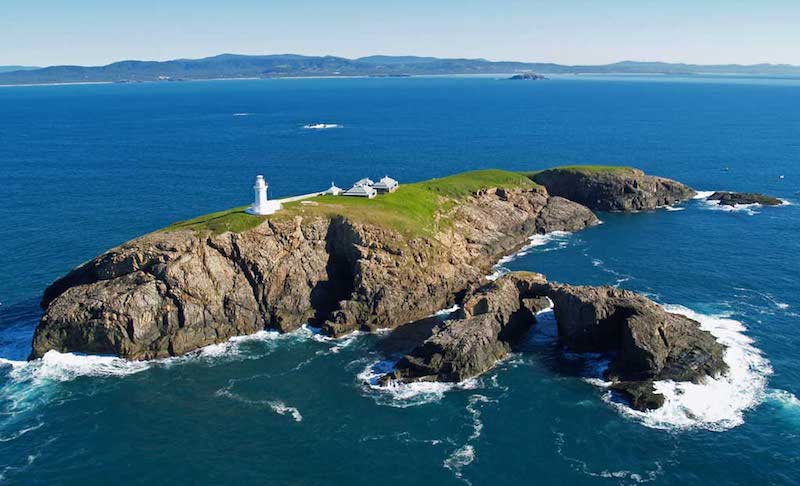
South Solitary Island website
Go to the great website of the history of the lighthouse at South Solitary Island with a click here!
Manta Arch (1)
The Light’s SHARK DIVE, with in excess of thirty Grey Nurse Sharks at one time, this dive is sure to get your adrenalin pumping. Situated near the northern tip of the island, there is an underwater arch surrounded with boulders and ridges peaking at 15 meters with gutters tailing down to 30 metres. The area is covered with large anemones and different varieties of Clownfish. Towards the island, from the arch, there is a pile of boulders rising up from 21 meters of water, this is the best place to watch the masses of schooling Pelagic fish.
Manta Arch… a classy Grey Nurse Shark dive…
This is South Solitary Island’s Grey Nurse Shark home.
Hang on for a great adventure!
Manta Arch has become over the years the iconic dive of South Solitary Island.
The Grey Nurse Sharks are a protected species, that is great to dive with it’s slow movements, and curious nature. When diving with them, we need to approach them carefully, so as not to scare them!
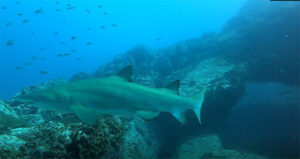
Manta Arch boasts in the Winter, “Grey Nurse Shark season”, the home of up to 60 Sharks. All this is an area as big as our shop!! As time has gone on, we have found that the grey Nurse sharks are staying in the area all year round. This summer we have had dives and counted over 40 different sharks in one dive!!
Manta Arch divesite features a deep archway over a narrow gutter, and is where the local Grey Nurse Sharks hang out! It appears this overhang and the depth of the gutters that surround the area, are magnets for these magnificent animals. Manta Arch is rated as a advanced divesite because of the depth, however if you know where you are going, you can do a 12 metre dive there too!
Hazards or Dangers
Currents:
Depending on the East Australian Current, Manta Arch Mooring can be exposed to quite strong currents, this can make it difficult to start the dive in this location.
Once underwater and near Little Birdy island, you can escape the major flow.
The current usually heads from north to south around the island, and can be too strong to swim against. Manta Arch on a small current day, is a great dive with the big Pelagics usually being attracted by the water movement. Be careful if you are diving from a boat without a surface watch! We do not recommend this in this area with that current!
Depths:
Manta Mooring is in 21 metres of water! Inexperienced divers who don’t understand multi-level diving principles, can easily go over their table limits and also slip into deco on their computer if they follow the bottom contour back to the mooring from shallower depths.
We recommend that the mooring line is used for all ascents, to avoid the possibility of popping to the surface, from that depth, divers are fooled by the expanding air in their vests (being a greater distance to ascend than our normal moorings). Rapid ascents have been responsible for Decompression Sickness at these deeper sites!
We usually operate our charter Dive Trips to Manta Arch with guidance on not only the location, but on diving with Grey Nurse Sharks!
We pride ourselves with following the code of conduct with diving with Grey Nurse Sharks.
Cleaner Station (2)
In addition the cleaner station itself, Barney the Loggerhead Turtle, and Charlie the Blue Groper are regular friends to visit here. Along with an array of marine life in the gutters and boulders, including Angelfish, Black Cod and Frogfish. Site 10m – 20m.
Big Fish, Small Fish.
Cleaner has all fish.
Cleaner Station is located right on the North eastern point of South Solitary Island. It has a large boulder blocking the entrance to the gutter which is a noted “Cleaner Station”
Cleaning Stations are an area where all species of fish take a break from hunting each other and spend a bit of time, getting a parasite “clean-up” by the resident “Cleaner Wrasse”
Cleaner Station mooring is 12 metres deep at the top of the mooring rock, and is surrounded by similar boulders siting in depths up to 18 metres. This area is known for Large Pelagics including big Kingfish and common sightings of Grey Nurse Sharks in the deeper areas.
Cleaner rock is blocking the entrance of the gutter that leads into Cleaner Cave. This cave is relatively short but offers protection to unusual animals for our area. Oranate ghostpipefish and Angler hand-fish have been sighted here, very unusual for this part of the world!
What you’ll see at Cleaner Station.
Hazards or Dangers
Currents: Depending on the season, Cleaner Station Mooring can be exposed to quite strong currents, this can make it difficult to start and finish the dive in the same location. (the Cleaner Station gutter itself is usually calm) The current usually heads from north to south around the island, and can be too strong to swim against. Cleaner Station on a small current day, is a good mooring to start a drift dive for a long duration. Beware! The current at this point can swing divers around the Eastern side of South Solitary, not the side to drift dive, usually!
Be careful if you are diving from a boat without a surface watch! We do not recommend this in this area with that current!
We usually operate our charter Dive Trips to utilize the currents, not fight them, We start at Shark Gutters or Cleaner Station and drift along the Boulder wall, finishing usually near the Gantry Mooring. This Drift Dive is a favourite of all who join us!
Grey Nurse Gutters (3)
The bottom of “Shark Gutters” features sliced gutters radiating out from the shore in depths from 10 meters to 18 meters. This area is well known for it’s abundant fish life and sightings of Grey Nurse Sharks. Schooling Kingfish, Silver Trevally, Jewfish, Pomfreds, Bullseyes and Tarwhine are often found in this area. Addiitonally, scattered amongst the boulders you will find anemone and clownfish, Blue Groper, Flute Mouth, lots of wrasses and bushes of black coral.
If you want Fish…Come and get it!!
Shark Gutters (short for Grey Nurse Gutters) is located right on the Northern end of South Solitary Island. It has a prominent feature, a Gutter! ( an underwater valley)
Shark gutters mooring is 12 metres deep, and is the start of a gutter between Birdie Island and Little Birdie rock which spans out from South Solitary Island in a northerly direction. This area is covered with rocks, with a moderate cover of corals and is unreal for animals of different species.
Why do they call it Grey Nurse Gutters?
Well, it was a home to a large amount of grey nurse sharks in years gone by, and now it is still possible to see these animals during the winter months here and even other times of the year we have the occassional sighting .
The “Shark Gutters” have a boulder wedged between the two sides of the gutter and offers a great swim thru adventure into the end of the gutter, that can hold a new mystery of what you could see, every time!
Hazards or Dangers
Currents: Depending on the season, Shark Gutters Mooring can be exposed to quite strong currents, this can make it difficult to start and finish the dive in the same location. (the gutters themselves are usually calm)
The current usually heads from north to south around the island, and can be too strong to swim against. Shark gutters on a small current day, is the best mooring to start a drift dive, as the current right at the top of South Solitary, may be stalled in this area
Be careful if you are diving from a boat without a surface watch! We do not recommend this in this area!
We usually operate our charter Dive Trips to utilize the currents, not fight them, We start at Shark Gutters or Cleaner Station and drift along the Boulder wall, finishing usually near the Gantry Mooring. This Drift Dive is a favourite of all who join us!
North Boulder Wall (4) & South Boulder Wall (5)
If prolific fish life is your liking, this dive is for you. Large boulders litter the top and cascade over the edge of the wall, levelling out to a comfortable 18 meters. This provides a perfect base for Crayfish to hide and corals full of tropical fish like Blue Tangs to thrive. Schools of fish are abundant with Silver Trevally, Goatfish, Tarwhine, Red Morwong and Snapper to name a few. During the winter, we have frequent encounters with Giant Cuttlefish along the wall which entices turtles to the island.
On most days this divesite has more fish than you can imagine…
Boulder Wall is located on the North Western corner of South Solitary Island. It has a very easily navigatable feature, the wall itself!
Boulder Wall has a platform type top which is between 8 and 12 metres deep spanning out from South Solitary Island. This area is littered with larger rocks and a haven for our residential fish.
We have two moorings on the wall; North Boulder, on the northern end and South Boulder on, you guessed it, the southern end!
Both moorings are on the edge of the wall, which is really obvious with its boulders cascading from a depth of 10-12 metres down to 18 metres.
The size of the boulders allow for untold nooks and crannies, that the local fish life use to hide. You never know what you might see along here
Predator pelagics often patrol along the wall, especially when a current it present.
Hazards or Dangers
Currents: Depending on the season, Cleaner Station Mooring can be exposed to quite strong currents, this can make it difficult to start and finish the dive in the same location. (the Cleaner Station gutter itself is usually calm) The current usually heads from north to south around the island, and can be too strong to swim against. Cleaner Station on a small current day, is a good mooring to start a drift dive for a long duration. Beware! The current at this point can swing divers around the Eastern side of South Solitary, not the side to drift dive, usually!
Be careful if you are diving from a boat without a surface watch! We do not recommend this in this area with that current!
We usually operate our charter Dive Trips to utilize the currents, not fight them, We start at Shark Gutters or Cleaner Station and drift along the Boulder wall, finishing usually near the Gantry Mooring. This Drift Dive is a favourite of all who join us!
The Gantry (6)
The site where the old Gantry crane for loading supplies onto the island collapsed into the water. A great shallower dive 12-15m, with lots of marine life and wreckage. A turtle haven!
Coming soon!
Buchanan’s Wall (7)
Towards the southern end of the island, we have a wall on the south-west side of a rock mass. Buchanan’s Wall starts at 15 meters, and ends at 30 meters. This is a good area for invertebrate life, including Nudibranch’s, Spanish Dancers, encrusting soft corals and anemone’s with clownfish that are big enough to wear boxing gloves!
Coming soon…
Cable Trail (8)
Just along from Buchanan’s Wall there is a boulder pile and associated rock masses. There is the remains of old trawl cable draped around the area, hence it’s name. This is another good area for fish and sightings of Grey Nurse. A large black ray resides in the area, and we often see cuttlefish here.
The divesite of Hidden Treasures
On the southern end of South Solitary Island is Cable Trail, named after the location of a Trawlers cable that allowed for easy navigation, now all but gone.
Cable Trail is a divesite that can be full of exiting and unusual fish one day, to a quiet and somewhat plain site the next. But it always has a hidden unusual critter that you would not find on other sites.
The mooring is located on the top of a 12-14 metre platform that has very large rocks spread over it.
Not far away from the mooring, as you head away from the island, the bottom drops away to 18 mtrs and follows in a south easterly direction the edge of the island, slowly getting deeper and deeper.
Hazards or Dangers
Currents: Depending on the season, Cleaner Station Mooring can be exposed to quite strong currents, this can make it difficult to start and finish the dive in the same location. (the Cleaner Station gutter itself is usually calm) The current usually heads from north to south around the island, and can be too strong to swim against. Cleaner Station on a small current day, is a good mooring to start a drift dive for a long duration. Beware! The current at this point can swing divers around the Eastern side of South Solitary, not the side to drift dive, usually!
Be careful if you are diving from a boat without a surface watch! We do not recommend this in this area with that current!
We usually operate our charter Dive Trips to utilize the currents, not fight them, We start at Shark Gutters or Cleaner Station and drift along the Boulder wall, finishing usually near the Gantry Mooring. This Drift Dive is a favourite of all who join us!
Other Sites
Other sites at the island include Archie’s Cave (9) and the Steam Boiler.
North Solitary Island
Anemone Bay, Fish Soup, Bubble cave. This Island has some unique sites…!!
North Solitary Islands is 25Nm north of Coffs Harbour and is often referred to as the “big” island.
North Solitary Island offers it’s own special sites, like “Anemone Bay” with it’s blanket cover of anemones and clownfish and “Fish Soup” with it’s abundant fishlife.
We run Charter Scuba Dive trips to North Solitary Island on an “as needs basis”, with about 75 minute boat trip each way.
Therefore, sea conditions must be suitable for a long trip. With these trips, we can easily dive 3 dives (using 2 tanks, with 1 tank doing 2 x 30 minute dives on the last two
Fish Soup
Fish Soup is a divesite that has a remarkable amount of fish, in just one little area. They all collect in this special point to hide, or feed in the current and swell.
A divesite not always accessible, but well worth a dive in the right conditions.
Anemone Bay
Reported to have the largest population of clown fish in anemones on the Australian coast, this is an interesting location.
Located on the northern side of North Solitary Island, Anemone Bay is large enough to hide from southerly swells and protect the anemone beds.
Hazards or Dangers
Currents: The East Australian Current can expose North Solitary Island to quite strong current. This can make it difficult to start and finish the dive in the same location.
The current usually heads from north to south around the island, and can be too strong to swim against. Anemone Bay, on a small current day, is a good location to dive from start to finish. It is important to be careful not to wander too wide or a drift dive will be on. Beware! The current at this point can swing divers around the Eastern side of North Solitary. This is not the side to drift dive!
Be careful if you are diving from a boat without a surface watch! We do not recommend this in this area with that current!
We usually operate our charter Dive Trips to be outside of the currents areas when there is that problem!
Split Solitary Island
Split Solitary Island is famous for its amazing gardens of Hard and Soft Corals, Cowry shells, Turtles, Morays and Lobster. It offers a further fantastic nine snorkelling and Scuba dive sites. Plus, it’s only 20 minutes by boat from Coffs Harbour. Split Solitary’s visibility is not always as clean as South Solitary Island, and quite often used as a backup dive site.
Shrimp Mooring, Cowry Mooring, Moray Mooring, Lobster Lair, Mike’s mooring and the Wall & Kingfisher Point
These dive sites are all on the south side of the island along an irregular drop-off. This marks the edge of a plateau about 10 meters deep running out from the island. At the foot of the drop, 15 to 18 meters down, the bottom is flat, slowly becoming deeper with occasional rock outcrops. On the plateau and along the drop-off the bottom is covered with hard and soft corals, sponges, ascidians, bryozoans, tube worms, algae’s and nudibranch’s. Also you will discover many species of resident fish, egg cowries, moray eels, banded coral shrimp, etc.
Turtle Cove
On the southern side of Split Solitary Island is Turtle Cove, a mooring lying on the eastern edge of a gutter full of life. The gutter starts in deep water and passes all the way along the edge of the island. Turtles, Nudibranchs and abundant fish are highlights to this area.
Cod Rock
Lies on the south-east side of the island opposite the “split”. This bommie is seperated from the fringing plateau by a gutter around 18 meters deep. This bommie rises to about 14 meters and then drops away to 21 meters. A large black cod around 2 meters long has been sighted here on several occasions, also blue devil fish are common hiding under overhangs. Additionally, there is a second bommie just to the north which is always covered in red morwong.
Coral Corner
Located on the north western corner where the bottom is in general flatter than the other sites. Here we have kelp beds and profuse growths of plate coral growing only a few meters apart. Shaped like a series of bays, the underwater terrain is separated by rocky headlands. This varies from 10 to 15 meters of water. Coral life is abundant in the bays, while other invertebrate life covers the headlands. Out in deeper water (18 meters) there are kelp beds. These beds attract turtles, seen frequently sleeping in the shallows.
South West Solitary Island
Also known as “Grouper ” Island – it is renowned for its plate corals and unusual fish sightings. Shallower sites (10-15m) make it a good snorkel and long dive site. Like Split Solitary Island, South West Solitary Island is closer to the coast and the visibility can be reduced compared to South Solitary Island
On the northern side of Groper Island or South West Solitary Island are two moorings (usually!), creating the perfect location for diving on a day of southerly winds. The moorings are located in 10-12 metres of water on the contour of deeper water and shallow 8 metre and shallower reef.
Eastern End Mooring
The Eastern end mooring has large gravel based gutters running into the island with rocky nooks as you venture around the eastern side of the island.
Western End Mooring
The Western mooring gently slopes away and has very prolific coral cover, the more interesting parts of this area are in the shallows with unusual fish to be found. Lots of Egg Cowry shells and nudibranchs.
The dive-site can get to 18 metres deep, but usually varying between 12 and 16 metres. Not as prolific with big fish compared to South Solitary, with usually poorer visibility, but on it’s day, South West Solitary can be a great dive.
Hazards or Dangers
Currents: No current usually, an ideal site for the first dive in the area, as it is an easy dive.
Be careful with your navigation this area has been known to get people lost! The visibility at South West Solitary is not always good, hence this problem.
Navigation tip! If you are getting deeper, maybe you are moving away from the island!
North West Solitary Island
North West Solitary Island has unique features like common sighting of manta rays in the warmer summer waters and grey nurses in winter. Again, like South West Solitary and Split Solitary Island, it is closer to the coast, with cooler waters and generally lower visibility.
On the western side of North West Solitary Island are three mooring (usually!), the perfect location for diving on a day of easterly style winds
North West Solitary Island is a divesite that like Split Solitary Island, can be amazing, with extensive Coral gardens of Plate coral, This site has gutters of fish with ridges of coral with a lot of macro life.
The moorings is located in 10-12 metres of water on the contour of deeper water and shallow 8 metre and shallower reef.
The divesite can get to 18 metres deep, but usually varing between 12 and 16 metres. Not a big fish divesite compared to South Solitary, and usually with less visibility. However at the warmer time of the year, Manta Rays are what we come for!, North West Solitary can be a great dive.
Hazards or Dangers
Currents: No current usually, an ideal site for the first dive in the area, as it is an easy dive.
Be careful with your navigation this area has been known to get people lost! The visibility at North West Solitary is not always good, hence this problem.
Navigation tip! If you are getting deeper, maybe you are moving away from the island!
Pimpernel Rock
Pimpernel Rock is located on the north western point of The Solitary Islands Marine Park, 40 nautical miles from Coffs harbour! It is an advanced dive site on it’s best day, because of a few factors; The sheer depth of the site, and the vulnerability of currents.
This area is known for Large Pelagic’s including big Kingfish and Mulloway and common sightings of Grey Nurse Sharks in the deeper cave areas.
Pimpernel Rock is mind blowing when you get the conditions right! The descent down the peak leads you into the entrance of the Cave which is more like a huge swim through! Within the cave you will find deep water marine life such as Sea Tulips and Sea Whips, not to mention all of the Grey Nurse Sharks! The Bottom of the Cave is 39 metres deep and areas around can get deeper.
Big Fish, Big Cave, Big Depth,…. Big Dive!!
This has some Big Mean Fish…!!
Pimpernel Rock has no mooring, it can be accessed by an anchor line placed in the correct position, however, you cannot dive the area from a private boat without a permit to do so. So the area is usually dived by one of the charter boats that travel to the site.
The site is not always friendly! Any current can be difficult and more than slight current, can make it a challenge beyond diver’s ability to get down to the site!
This area is known for Large Pelagics including big Kingfish and Mulloway and common sightings of Grey Nurse Sharks in the deeper cave areas.
Pimpernal Rock is mind blowing when you get the conditions right! The descent down the peak leads you into the entrance of the Cave that is more of a huge swim thru than a cave.
This cave is the size of a tunnel that would allow a Semi Trailer Truck through! Within the cave is deep water marine life. Sea whips and Sea Tulips are something that you notice that are different, as these species don’t thrive in shallow depths. The Bottom of the Cave is 39 metres and areas around can get deeper. This means your dive time is very limited with the depth, but if you multi-level with the use of computers, you will extend your bottom times.
Nitrox can be an amazing difference in this site, especially if you plan 2 dives on the area.
Dive times are relatively short but offers some amazing animals for our area. To have Kingfish and Mulloway cruise close to you and know they are bigger than you is nothing short of exciting! Truely an Advanced to very Advanced Dive-site and should be done only with extra preparation and planning!
Hazards or Dangers
Currents: The East Ausstralian Current can expose Pimpernel Rock to quite strong currents. This can make it difficult to start and finish the dive in the same location. (The Pimpernel Rock gutter itself is usually calm)
The current usually heads from north to south around the Rock, and can be too strong to swim against. Pimpernel Rock on a small current day, is a great to Dive. Beware, however, as the current at this point can swing divers out into the deep blue sea!
Be careful if you are diving from a boat without a surface watch! We do not recommend this in this area with that current!
We run charter Dive Trips on calmer days, If there is no current and looking good, we start at the Jetty Dive shop EARLY!! Pimpernel Rock is 1.5+ hours north by boat. Due to the extended distance we charge extra, with a minimum of 10 divers and a maximum of 12 divers, diving in 3 groups led by our Divemasters or Instructors.
Minimum experience: Advanced Open Water with at least 30 dives recently (including Deep Diving).
Other Local Dive Sites
Our other great dive sites on the Coff’s Coast include
Black Rock (10-30m)
The Wash (15-30m)
Marsh Shoal (12-25m)
Split Bommie (10-20m)
Bullocky Reef (10-30m)
